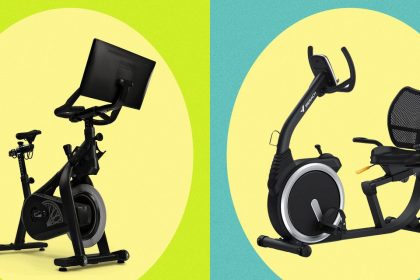You get out of bed in the morning or stand up after a long stretch of focusing at your desk. When your foot hits the floor, a sharp sensation shoots up the bottom of your heel, almost as if you’ve stepped on a nail, or like a pebble’s worked its way into your shoe.
Sound familiar? Chances are, you have a condition called plantar fasciitis, which occurs when the thick band of tissue that connects your heel to your toes becomes inflamed, Alyssa Carroll, DPM, a sports podiatrist in Raleigh, North Carolina, tells SELF. It’s painful, annoying—and actually pretty common. Plantar fasciitis affects more than two million people in the US yearly. Leada Malek, DPT, CSCS, a spokesperson for the American Physical Therapy Association, tells SELF she typically sees at least two patients weekly who are coping with it.
Heel pain (and the accompanying aches that can come with it) can interfere with your workout routine and your everyday life, even making walking painful and causing you to alter your gait in ways that can lead to other problems. Here’s more about why it happens—and how to get some relief for your feet.
What causes plantar fasciitis, and who’s at risk?
The plantar fascia plays a key role in propelling your foot forward as you walk. When you step down and put weight through your heel, your toes begin pointing upward, tightening the tough band of tissue. This response—known as the windlass mechanism—supports your arch as you stride, so you can roll through to the next step.
But this design, while elegant, isn’t foolproof: “By nature, it’s pulling on the insertion point,” or where the ligament-like tissue connects to the heel bone, Dr. Malek says. “That tensile load can surpass its capacity.” The overstressed tissue, either along your arch or right next to your heel, can then sustain tiny tears and become irritated, inflamed, and painful.
Sometimes, foot anatomy plays a role in overloading the plantar fascia and causing inflammation and pain, Dr. Carroll says. Flat feet often contribute to overpronation, when your foot rolls farther inward with every stride, adding extra tension. Meanwhile, high arches can lead to underpronation—when your foot rolls outward—adding strain from the other direction.
Tight calves can also pull on your Achilles, which then tugs on your plantar fascia, since both attach to your heel bone. “It’s kind of this lever system; if one’s tight, the other is also tight,” Dr. Carroll says.
High-impact sports, like running or HIIT classes, can irritate the plantar fascia, especially if you ramp up quickly without giving your body time to adapt to the pounding. “It’s usually too much, too soon, too fast,” Leah Avery, DPT, PT, a physical therapist and running coach in Bentonville, Arkansas, tells SELF. For example, your risk increases if you start running and immediately go from zero to five days a week.
Running, walking, or hiking on an incline can also add extra strain, as can beach volleyball or other activities performed on sinking or uneven surfaces. Combining any of these factors with a job that keeps you on your feet all day, especially on a hard surface, may cause plantar fasciitis to develop or worsen more quickly, Dr. Avery says.
What are the signs and symptoms of plantar fasciitis?
Post-static dyskinesia—the official term for that stabbiness upon taking your first few steps—is a hallmark sign of plantar fasciitis. When you’re sitting or sleeping, the plantar fascia tightens. Then, “when you go to stand back up, on a microscopic level, everything is kind of ripping back open,” Dr. Carroll says.
The resulting pain can range from minor to severe and may ease as you move around, since that stretches out the tightened ligament. But it’s likely to return after a period of rest or again later in the day. You might also get pain along your arch, swelling around your heel, or tightness around your Achilles tendon.
Do shoes have anything to do with it?
Footwear doesn’t typically cause plantar fasciitis, but flats or similarly unsupportive shoes can aggravate an existing case, Dr. Carroll says. “Grab your shoe, and if you can easily bend it in half or wring it out like a towel, it’s not going to be a great option when you’re dealing with plantar fasciitis,” she says. “You want the sole of the shoe to be more rigid and give that foot a little bit more support from below.”
How can you treat plantar fasciitis at home?
You can begin by managing minor cases of heel pain at home through methods like stretching your calf and Achilles, wearing supportive shoes, and backing off from activities that worsen it, Dr. Carroll says. Note: This doesn’t necessarily mean you need to stop exercising.
In fact, resting completely and then jumping right back into your previous routine is exactly the wrong approach, Dr. Avery says. But if an activity is causing your pain to worsen, you might try (temporarily) switching to something lower-impact—say, cycling or swimming instead of running.
Mobilizing the tissue throughout the day by rolling your foot on a massage, lacrosse, or tennis ball can also ease discomfort, as can self-massage and ice, Dr. Malek says. But don’t overdo it—a study in the Journal of Clinical and Diagnostic Research found three sets of 30 seconds of rolling daily is enough to improve symptoms.
If your plantar fasciitis is persisting despite home care, it’s time to loop in the pros.
If your heel pain and other symptoms don’t improve within two or three weeks, it’s a good idea to seek treatment from a podiatrist, physical therapist, orthopedist, or other sports medicine provider. Typically, the sooner you get help, the faster you’ll heal, Dr. Malek says.
“Be patient; it can be stubborn sometimes,” she says. But with a smart treatment plan, your symptoms will likely improve quickly and resolve completely within a few weeks or months.
In general, your treatment will likely have two parts: relieving the initial pain and inflammation, as well as addressing the underlying causes, as Dr. Carroll describes it.
For relief, she often recommends anti-inflammatory medications—think ibuprofen and naproxen—in either over-the-counter or prescription strength. A cortisone shot can also calm inflammation quickly. Your healthcare provider might put you in a walking boot to immobilize and reduce the weight you’re putting on the foot as it subsides, Dr. Malek says.
But there’s also a group of newer treatments that work by actually encouraging the inflammatory response—after all, it’s how our body naturally heals. These include laser therapy and a type of shockwave treatment known as extracorporeal pulse activation technology (EPAT).
Often, these require less rest or downtime: “We have colleagues who are using the shockwave on the court before basketball games, and on the field before football games, literally as the athletes are going out to play,” Dr. Carroll says. “That’s a really nice option for our active patients.”
Another newer treatment is platelet-rich plasma; doctors draw some of your own blood, spin it into a centrifuge to isolate specific compounds called growth factors, then inject it back into your heel to promote healing.
Then, there are the steps to address the underlying cause, preferably guided by an expert like a physical therapist. That includes stretching exercises for tight calves. A night splint can also help by lengthening your calf, Achilles, and plantar fascia as you snooze, Dr. Malek says.
While you’re in the throes of plantar fasciitis, you’ll want to wear supportive shoes and avoid going barefoot. But once your pain has subsided, it’s actually a good idea to do some barefoot walking or other exercises to strengthen and mobilize the small, intrinsic muscles in your feet to better support your plantar fascia, Dr. Carroll says.
Specific foot-strengthening movements might include towel scrunches, banded ankle exercises, and calf raises, Dr. Malek says. But any lower-body exercise done barefoot—think lunges and calf raises, progressing to plyometrics—can help, Dr. Avery says.
There are things you can do to prevent plantar fasciitis from coming back too.
If you’ve had to take some time off running or other high-impact activities, ease back in gradually once you’re cleared, Dr. Avery says. (You might not have to wait until you’re completely pain-free, she notes: Of course, your health care team will advise, but you can often resume if your pain is below a three on a scale of 1 to 10, doesn’t alter your gait, and isn’t worsening.) Also, make sure you warm up thoroughly before each session, so your tissues are prepared for the load, Dr. Malek says.
In addition, wear sneakers that are appropriate for your activity—this list of expert-approved shoes for plantar fasciitis is a great place to start. For example, if you’re playing pickleball, tennis, or another sport that involves side-to-side motion, you’ll want a shoe that has lateral support. Otherwise, the extra strain on your foot can pull on your plantar fascia, Dr. Carroll says.
Then, replace those kicks regularly; running shoes, for example, typically last about 300 to 400 miles before the foam loses its shock absorption ability. And if your foot anatomy plays a role—for instance, if you have flat feet—you might also benefit from orthotics, Dr. Carroll says.
Beyond that, keep up with the stretching and strengthening exercises—and dedicated barefoot walking time, even if it’s just around your kitchen—that helped you beat the pain in the first place. And the next time you start a new routine or ramp up your existing one, resist the urge to go all-in right away. “Be aware of what you’re asking of your body,” Dr. Avery says. “Make sure it’s not an all-or-nothing approach and that you gradually build up.”
Related:
- 6 Common Habits Podiatrists Say Are Wrecking Your Feet
- Why Your Big Toes Play Such a Huge Role in Your Health
- The Best Breathable Shoes for People With Sweaty Feet
Get more of SELF’s great fitness content delivered right to your inbox.







